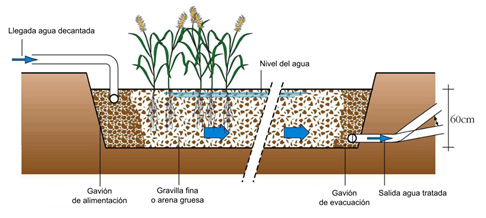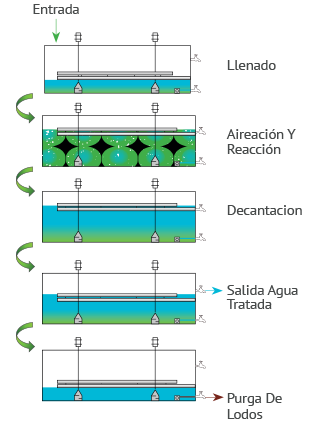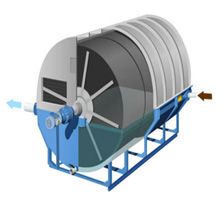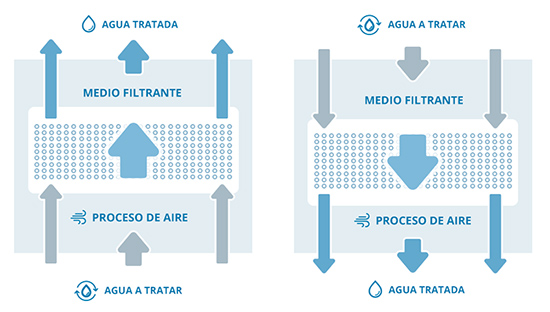Waste Waters
WES offers technical solutions adaptable to the treatment of urban waste water and industrial liquid waste (ILW).
The wastewater treatment consists of a series of physical, chemical and biological processes to remove contaminants present in the water and generates productive processes.
These treatment processes are given below:
- Pretreatment and primary treatment: settling of solids and fats (grinding, sanding-scouring, DAF, coagulation-flocculation)
- Secondary treatment: biological treatment of dissolved organic matter present in wastewater, transforming it into suspended solids to be removed. Bacterial cultures are used in different ways. Traditionally, three processes are distinguished: Free cultures (aerated lagoons, Wetland, SBR Activated Sludge), fixed cultures (Biofilters, Biodiscs, Trickling Filte /MBR) and hybrid cultures (Fluidized and Mixed cultures).
- Tertiary treatment: the aim is to sanitize and bring the water to the urban consumer and industrial applications requiring high purity water (adsorption, ion exchange, membranes)
Coagulation-flocculation
Some contaminants in water are exceptionally fine and the mechanism of agglomeration can be difficult due to the electrical effects to overcome. Furthermore, the process can become even more difficult if the amount of solids to be removed is low.
Coagulation-flocculation is the process of creating the right conditions so that these particles can be joined to form flocs, which will be easily decanted, producing good quality treated water.
The coagulation-flocculation process allows, due to the mixture of iron salts or aluminum and lime, the disruption of the colloidal suspensions’ stability, leading to the formation of flocs.

ADVANTAGES
- Efficient in the pretreatment process, it reduces organic matter for their subsequent biological treatment
- It requires a minimal investment
- Secure Technology
DAF
The dissolved air flotation method is a process of separating solid particles (suspended solids), liquid (oil and grease), and sludge concentration. It consists in attaching the particles entering the floater, in small air bubbles, so that these form a set of lower density than water and float; thus, it is possible to separate water particles of higher density than this. When dissolved air flotation is preceded by a coagulation-flocculation treatment, performance in the separation of suspended solids is much higher, being able to easily remove 95% of it; this also means a reduction of the BOD in the order of at least 40%, depending on the type of discharge.
WES offers this technology as pretreatment for industrial waste water with high fat and organic matter (dairy industry, pig manure, slaughterhouse, paper industry, timber industry and fish farms, etc.).
ADVANTAGES
- Reduction of organic matter content for later biological treatment
- Lower polymer consumption
- Easy to operate
- Small installations in comparison with sedimentation tanks
Independent Cultures
In independent techniques, the development of a bacterial culture is produced in the effluent to be treated, in the form of flocs scattered in a pool, pond or reactor. The reactor is agitated/aerated to maintain the cultures in suspension, favoring even distribution of oxygen needed by bacteria for their energy needs and reproduction.
AEREATED LAGOONS

This technology is based on using a large available area (dimension of the reactor), which allows to: obtain a flow or slow retention time (favoring the present biomass), mineralize organic matter and produce a reduced volume of sludge that accumulates at the bottom of the reactor or pond. The first emptying of this sludge is performed after 7-10 years of system operation.
It is an adapted solution for domestic waste water, for a population between 400-5,000 inhabitants.
ADVANTAGES
- Optimized oxygenation, maximal gradient of O2 transference
- Low sludge generation
- Low cost maintenance and operation
- Low power consumption
WETLANDS


Artificial wetlands allow treating mainly domestic waste water through the principle of phytoremediation (vegetable). Aerobic waste water purification is accomplished mainly through the microorganic biomass present in the substrate and on the surface of plant roots. Moreover, as the waste water passes through the substrate, which acts as a filter medium, some of the particles are retained in the bed to be mineralized by the biomass.
There are two types of wetlands:
VERTICAL: a batch type system, or discontinued, where the water penetrates quickly, generating a strong aeration due to the discontinual discharges of the affluent and the collectors.
HORIZONTAL: a continuous system where the water passes through the fully saturated substrate, so that the transfer of O2 is lower.
ADVANTAGES
- Odorless
- Low sludge generation
- Low maintenance and operational costs
- Perfect integration in landscaping
Activated Sludge – SBR
Bacteria consume dissolved organic matter to multiply, producing easily settleable sludge – which will be recirculated or purged from the process. The SBR (Sequential Biologic Reactor) process allows to reproduce all necessary water purification stages in only one pond or reactor.
The various stages taking place in the reactor are detailed here.

FILLING: the water to be treated is sent to the reactor, where there are bacterial colonies ready to degrade the organic pollution.
DEEP AEREATION: once the feeding ends, aeration allows the bacteria, in parallel with the consumption of organic matter, to multiply. The natural bacterial floc is reinforced.
DECANTING: the biomass is left to rest so that it settles at the bottom of the reactor, and the water is ready to be clarified.
EMPTYING OF THE TREATED WATER: the clarified water is removed.
SLUDGE PURGE: excessive sludge is extracted; the remains stay in the reactor in order to maintain the biomass needed to degrade the organic matter present in the next volume of waste water to be treated.
WES uses modified shipping containers to manufacture their SBR, which allows modularity and improves mobility of their units. These compact plants are designed for locations with little space and are ideal in communities from 100 to 5,000 inhabitants.
ADVANTAGES
- Compact system
- Quick installation and implementation
- Autonomous and modular units
- Easily operated
- Environmental integration
- Low noise level
- Odorless
- Reuse of treated water for irrigation
Fixed Cultures
In the fixed cultures processes, the ability of reproducing expolymers that most micro-organisms have is used because it allows them to adhere, in the shape of biofilm, to a variety of media. This biofilm is developed across the entire medium surface, and the production of new bacterial cells leads to increased thickness. Oxygen and soluble nutrients are transported by the water to be treated, which is diffused through the biofilm. The fixed bacteria generally have higher specific activity levels than those observed in free cultures. To optimize a treatment line using fixed cultures, the effluent should be pretreated by decanting or, at least, by a good sieving. The activity of a bacterial culture depends, particularly, on the exchange surface between substrate and oxygen. In activated sludge (free cultures), this surface is restricted due to the microorganisms flocculation state.
There is a variety of growth media, where these should be highlighted:
PERCOLATING FILTERS OR BACTERIAL BEDS
The biofilm is fixed on highly porous inert media. A sprinkling of the water to be treated is discharged while a flow of air circulates continuously, from the bottom up. This process uses non-submerged fixed cultures.
ADVANTAGES
- It handles a wide effluent variety (organic load and inflow)
- It produces stable sludges, easy to decant
BIODISCS

This technique consists of a series of close-set circular discs that are partially submerged (usually 40%) in the water to be treated, which rotate around a horizontal axis. This rotation puts the biomass developed on the discs in alternating contact with water and oxygen in the air.
ADVANTAGES
- Optimized oxygenation maximum gradient of O2 transfer
- Minimum sludge management
- Low cost maintenance and minimum risk of failure
BIOFILTERS

When the microorganisms adhere to less than 5 mm effective sized granular media, the specific exchange surface is very important. This realization led to biological filters development, where the granular medium to which bacteria adhere is immersed in the water to be treated. Aeration is accomplished by supplying air to the base of the filtering means. The granular medium also serves as a separator.
ADVANTAGES
- Modularity: biomass properly handles inactivity periods, and implementation is simple after retention
- Handles large variations of the effluent (organic load and inflow)
- Production of stable sludge – easy to decant
- Functions on gravity – saves energy
Fluidized and Mixed Cultures
In the case of fluidized cultures used in the treatment of urban waste water, bacteria adhere to considerably fixed and/or light media so that they remain in suspension in the bioreactor. These media materials (Biomedia), of a density close to water and of small size, are set in motion and kept submerged in the biological tank through sufficient agitation. Given its large surface area, from 200 to 800 m²/ m3, these materials are able to withstand a significant biomass in the form of biofilm (mainly inside the material).
As a result, the effective volumes of the tank are greatly reduced. In any case, maintaining media in the reactor means that, at its output, retention grids are needed with spaces adapted to the size of the material. For this process, called Moving-Bed Biofilm Reactor (MBBR), a large amount of media material must be introduced, which should occupy between 30% and 60% of the reactor volume.
This type of growth culture provides a high response capacity and a true treatment flexibility thanks to the massive proliferation of bacteria on the media. Thus, biomass better responds to possible load variations, inflow or temperature.
Due to a substantial surface for colonization offered by these media structure, the reactors are two times smaller than those which solely function in free culture. This advantage allows to solve limitations of space and reduce civil work costs.
ADVANTAGES
- Lower investment, requiring a smaller reactor size
- Large capacity of nitrogen and phosphorus removal
- Low sludge production
